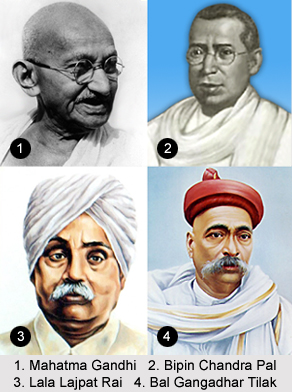 Swadeshi Movement was a popular strategy for eradicating the British rule and for improving the economic conditions of the country. The concept of Swadeshi, as per Mahatma Gandhi, was to attain self-sufficiency which included employment of unemployed people by encouraging village industries and towards building a non-violent society. Thus, the main policies of the Swadeshi Movement included boycotting all types of British products and the restoration of all domestic products. The chief forerunners of Swadeshi Movement were Bal Gangadhar Tilak, Lala Lajpat Rai, Bipin Chandra Pal, Aurobindo Ghose and Veer Savarkar. The writings and speeches of Bal Gangadhar Tilak and his associates paved the initial way. Tilak reached out to the masses through popular festivals. He transformed the traditional Ganapati Utsav into a public celebration where patriotic ideas could be spread. Later, he inaugurated a Shivaji festival for the same purpose. In 1906, Bengal honoured the great Maratha as a national hero.
Swadeshi Movement was a popular strategy for eradicating the British rule and for improving the economic conditions of the country. The concept of Swadeshi, as per Mahatma Gandhi, was to attain self-sufficiency which included employment of unemployed people by encouraging village industries and towards building a non-violent society. Thus, the main policies of the Swadeshi Movement included boycotting all types of British products and the restoration of all domestic products. The chief forerunners of Swadeshi Movement were Bal Gangadhar Tilak, Lala Lajpat Rai, Bipin Chandra Pal, Aurobindo Ghose and Veer Savarkar. The writings and speeches of Bal Gangadhar Tilak and his associates paved the initial way. Tilak reached out to the masses through popular festivals. He transformed the traditional Ganapati Utsav into a public celebration where patriotic ideas could be spread. Later, he inaugurated a Shivaji festival for the same purpose. In 1906, Bengal honoured the great Maratha as a national hero.
There were many other factors behind the growth of `The new spirit in India`. It was widely accepted by everyone that Britain was the cause of the country`s poverty. Three noteworthy books were published in the year 1901, which focused on the details of how Britain`s policies had destroyed India. The names of the books can be mentioned as Dadabhai Naoroji`s Poverty and Un-British Rule in India, R. C. Dutt`s Economic History of India, and William Digby`s ironically titled Prosperous British India.
India was the country with once flourishing economy. At the same time the true face of European imperialism was being revealed. The belief in the supremacy of the imperial powers` military was being challenged. Moreover, various revolutions around the globe, like that in Ethiopia, Japan and others, had started to weaken Europe`s rule over Asia. The Partition of Bengal went into effect on 16th of October, 1905, which was observed as a day of mourning in Bengal. Normal and usual life had come to a halt on that unfaithful day. In Kolkata, thousands walked barefoot in silent processions to a mammoth meeting where the cornerstone of a federation hall, monument to United Bengal, was laid. The ceremony of Raksha Bandhan was given a new turn, where the yellow thread that the people tied to one other`s wrists, symbolised the brotherhood between each other.
The Swadeshi movement quickly gathered force in the country. Burning of British cloth in public places demonstrated the people`s determination not to rely on foreign products. The sale of English goods fell drastically, as Bombay Mills worked overtime to meet the demand for Swadeshi textiles. It became a matter of national and personal pride to wear coarse dhotis woven on local handlooms rather than fashionable Manchester cottons. Student volunteers further encouraged people to use Indian products. Popular enthusiasm was sustained by songs written by Rabindranath Tagore and others. Vande Mataram by Bankim Chandra Chatterjee became the national anthem. Further, the Swadeshi movement gave tremendous inputs to Indian industries. Home grown salt, sugar, matches and other products had started to be manufactured on native soil. On a larger scale, the movement gave a stimulus to Prafulla Chandra Roy`s Bengal Chemical Works. This action encouraged Jamshedji Tata to open his famous steel plant in Bihar. At the same time, Indian labours took their first real steps towards organisation. A series of strikes in Kolkata and other places demonstrated that the working class was growing weary of exploitation.
Swadeshi Movement was described by Mahatma Gandhi as the soul of self rule in the country.



















